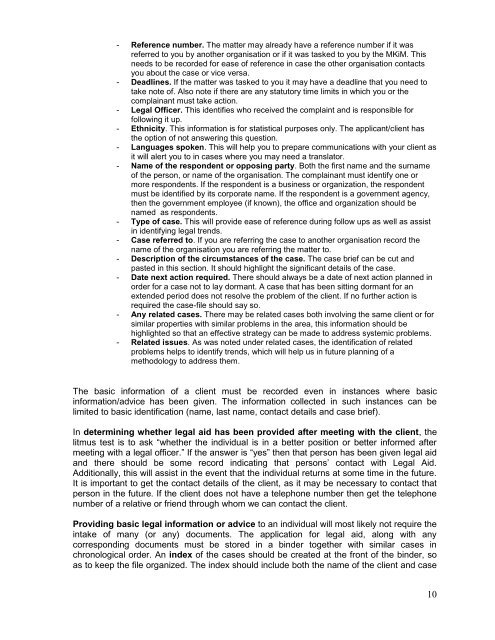Serbia Handbook for Legal Aid Providers Final
Serbia Handbook for Legal Aid Providers Final
Serbia Handbook for Legal Aid Providers Final
Create successful ePaper yourself
Turn your PDF publications into a flip-book with our unique Google optimized e-Paper software.
- Reference number. The matter may already have a reference number if it was<br />
referred to you by another organisation or if it was tasked to you by the MKiM. This<br />
needs to be recorded <strong>for</strong> ease of reference in case the other organisation contacts<br />
you about the case or vice versa.<br />
- Deadlines. If the matter was tasked to you it may have a deadline that you need to<br />
take note of. Also note if there are any statutory time limits in which you or the<br />
complainant must take action.<br />
- <strong>Legal</strong> Officer. This identifies who received the complaint and is responsible <strong>for</strong><br />
following it up.<br />
- Ethnicity. This in<strong>for</strong>mation is <strong>for</strong> statistical purposes only. The applicant/client has<br />
the option of not answering this question.<br />
- Languages spoken. This will help you to prepare communications with your client as<br />
it will alert you to in cases where you may need a translator.<br />
- Name of the respondent or opposing party. Both the first name and the surname<br />
of the person, or name of the organisation. The complainant must identify one or<br />
more respondents. If the respondent is a business or organization, the respondent<br />
must be identified by its corporate name. If the respondent is a government agency,<br />
then the government employee (if known), the office and organization should be<br />
named as respondents.<br />
- Type of case. This will provide ease of reference during follow ups as well as assist<br />
in identifying legal trends.<br />
- Case referred to. If you are referring the case to another organisation record the<br />
name of the organisation you are referring the matter to.<br />
- Description of the circumstances of the case. The case brief can be cut and<br />
pasted in this section. It should highlight the significant details of the case.<br />
- Date next action required. There should always be a date of next action planned in<br />
order <strong>for</strong> a case not to lay dormant. A case that has been sitting dormant <strong>for</strong> an<br />
extended period does not resolve the problem of the client. If no further action is<br />
required the case-file should say so.<br />
- Any related cases. There may be related cases both involving the same client or <strong>for</strong><br />
similar properties with similar problems in the area, this in<strong>for</strong>mation should be<br />
highlighted so that an effective strategy can be made to address systemic problems.<br />
- Related issues. As was noted under related cases, the identification of related<br />
problems helps to identify trends, which will help us in future planning of a<br />
methodology to address them.<br />
The basic in<strong>for</strong>mation of a client must be recorded even in instances where basic<br />
in<strong>for</strong>mation/advice has been given. The in<strong>for</strong>mation collected in such instances can be<br />
limited to basic identification (name, last name, contact details and case brief).<br />
In determining whether legal aid has been provided after meeting with the client, the<br />
litmus test is to ask “whether the individual is in a better position or better in<strong>for</strong>med after<br />
meeting with a legal officer.” If the answer is “yes” then that person has been given legal aid<br />
and there should be some record indicating that persons’ contact with <strong>Legal</strong> <strong>Aid</strong>.<br />
Additionally, this will assist in the event that the individual returns at some time in the future.<br />
It is important to get the contact details of the client, as it may be necessary to contact that<br />
person in the future. If the client does not have a telephone number then get the telephone<br />
number of a relative or friend through whom we can contact the client.<br />
Providing basic legal in<strong>for</strong>mation or advice to an individual will most likely not require the<br />
intake of many (or any) documents. The application <strong>for</strong> legal aid, along with any<br />
corresponding documents must be stored in a binder together with similar cases in<br />
chronological order. An index of the cases should be created at the front of the binder, so<br />
as to keep the file organized. The index should include both the name of the client and case<br />
10


